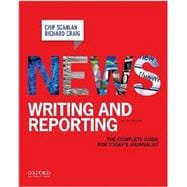News Writing and Reporting: The Complete Guide for Today's Journalist, Second Edition, uses a multitude of reporting and writing examples from print, broadcast and online sources in order to deconstruct and reveal journalistic practices, techniques and philosophy to today's students. Building on a solid foundation of the three pillars of excellent journalism--process, coaching and storytelling--Chip Scanlan and Richard Craig shape students into successful journalists by providing them with the theoretical background and practical knowledge needed to transition into a new age of reporting.
What's New to the Second Edition?
* "Journalists at Work" boxes provide illuminating profiles of professional journalists
* "Quick Tips" boxes offer practical advice and checklists on how to accomplish the myriad tasks that journalists face daily
* "Chip's Corner" boxes provide varied and insightful accounts from author Chip Scanlan's nearly two decades of journalistic experience
* "Ethical Dilemmas" case studies recount real-world situations that challenge students to think critically about the limits of journalistic fairness and accuracy
* "The Coaching Way" boxes feature advice and questions that guide students toward excellent and ethical journalism
* "Professionals Roundtable"boxes are comprised of interview transcripts with industry insiders, journalism professors and leading authors
* "Close-Ups" highlight the strengths and potential problems found in real journalistic practice with annotated walkthroughs of actual print, broadcast and online journalistic pieces. More of these walkthroughs will be available to students on the Companion Website (www.oup.com/us/scanlan).
Need more practice? Call customer service at 800-280-0280 to order News Writing and Reporting: The Complete Guide for Today's Journalist's student workbook (ISBN: 978-0-19-998085-7).
A Word to Aspiring Journalists from Chip Scanlan
Cultivate curiosity. Do what you fear. Collaboration, especially in online journalism, is key. Master technology, but never forget that tools enhance your capabilities and the basics of good journalism never change. You may have to start out small, but jobs are out there for journalists who are committed to public service. That is the heart of excellent journalism. Never stop learning. Never give up. Have fun.








